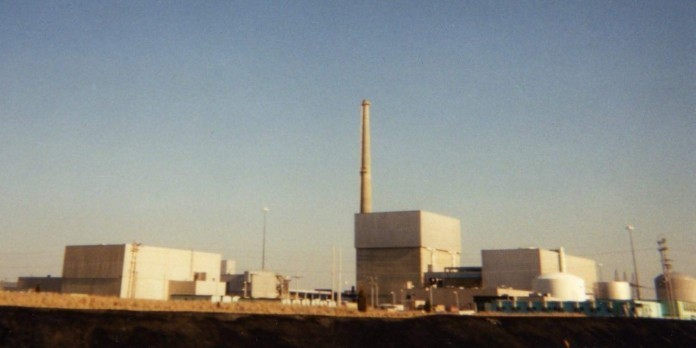
LACEY – Local and state officials discussed the future of the Oyster Creek Nuclear Power Plant, which is in the process of closure.
Locally, the closure of the plant means a steady decline in tax revenue until something comes in to take its place.
The issue came up at the April 13 Township Committee meeting when Public Works employee Kevin Flynn asked for more money and support for the department. There are vehicles past their useful lifespan, and roads that need to be paved. The town, he said, needs to support the department better so they can continue to do the work that needs to be done in town.

Township Committee members outlined purchases that have been made and projects that were done. However, “We can’t do everything every year,” Mayor Peter Curatolo said.
As the plant continues its closure, which will likely take many years, the revenue coming in to the town will slowly decline. The town has to prepare for that financially.
“We don’t want the legacy to be poor planning,” he said.
Committeeman Steven Kennis pointed out what happened to two towns – Vernon, Vermont and Zion, Illinois – when their nuclear plants closed.
When Vermont Yankee Nuclear Power Plant closed, its host town of Vernon, Vermont had to disband its police force.
According to local newspaper the Brattleboro Reformer, the residents had a referendum to determine whether to make the cut. Local police were closed, as well as other services in its 2015 fiscal year budget. By way of comparison, Vernon’s proposed total town budget was about $2.1 million. Lacey’s budget is about $30 million.
In Zion, Illinois, many of the houses were abandoned. They were bought up by landlords and turned into rentals, bringing property values down in the town.
The Chicago Sun-Times wrote in January that the $19.5 million in taxes that Zion Nuclear Power Station brought in went down to $1.5 million after it closed in 1998. The mayor of the town refers to the spent fuel rods still being stored there as “a nuclear waste dump.”
These were both worst case scenarios, Kennis said. However, if no gas line is approved to turn the property into a gas-electric plant, or some other large tenant doesn’t go there, the worst case scenario might happen.
“Unless something changes, everyone will have to do more with less,” he said.
Committeeman Tim McDonald acknowledged that the town has a problem with outdated equipment, and public works has been frustrated with not getting the equipment needed to do everything that needs to be done. However, the closing plant has shaded every financial decision they make.
 “I am scared to death” of what could happen to the town when the plant closes without an alternative tenant, he said.
“I am scared to death” of what could happen to the town when the plant closes without an alternative tenant, he said.
“Those fuel rods will never leave Lacey Township,” he said, regretting this, because Lacey had never agreed to store the material forever. Yucca Mountain, the nuclear waste repository, has been closed.
Time is of the essence in getting a new tenant in the spot, because 60 nuclear plants are going offline by 2025. That means every town will be looking for new tenants. There are a limited number of companies that are looking for new real estate of this nature and Lacey can’t be left behind, he said.
“We have to make it attractive to come in,” he said, noting the town has been working with lawmakers to help smooth the way.
A resident, Jesse Ehrnstrom, who is running for committee, suggested a wind or solar farm as a measure to help out with taxes and energy needs now, because the regulations to get a new tenant could take years and years.
McDonald said it would still take years to get a solar or wind farm approved.
The DEP and Oyster Creek
Department of Environmental Protection Commissioner Bob Martin spoke recently to the Ocean County Mayor’s Association. After the meeting, he spoke with the Southern Ocean Times about the fate of the spent fuel rods.
“We’ve been working with (parent company) Exelon, and the Nuclear Regulatory Commission,” Martin said. “Right now, the fuel will remain there.”
The fuel rods have to cool for at least five years, then stay in dry casks for even longer.
“We’d prefer to move them sooner rather than later. The bigger challenge is that there is no storage in the country,” he said.
The NRC and Oyster Creek

Meanwhile, the Nuclear Regulatory Commission cited plant owner Exelon for deficient maintenance work.
Inspectors, in 2016, saw a problem with one of the five electromatic relief valves, which would be used to depressurize the reactor during a pipe break.
It was determined to be a “white” safety finding. On the color-coded chart to determine problems, white means “low to moderate” safety significance. It is just above a green finding, but below yellow and red. It is the lowest finding that would require additional NRC oversight.
“These valves serve a key safety function and therefore it is important that they be available to help mitigate severe accidents at the plant,” said NRC Region I Administrator Dan Dorman.
This caused the NRC to perform a supplemental inspection to make sure the problem has been fixed, the release stated. Upon its return, the problem was fixed.
Exelon’s Site Communication Manager Suzanne D’Ambrosio released a statement to the press about the incident: “Exelon Generation and the NRC share a common goal of safe and excellent operations. While we appreciated the opportunity to discuss our concerns with this potential white finding, we are disappointed in the results. As always, we will continue to work alongside the NRC to ensure that Oyster Creek is operated with the highest level of safety and precision.”
She did not comment on the fate of the spent fuel rods for this story.






